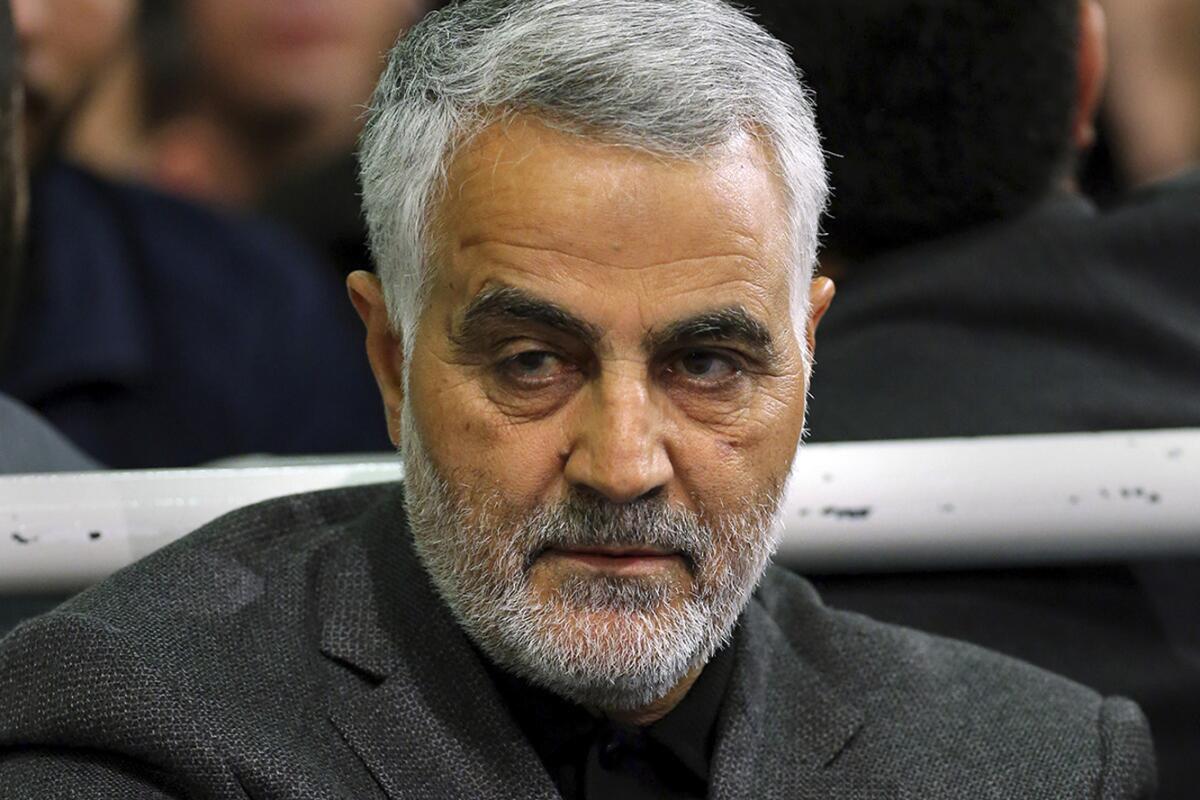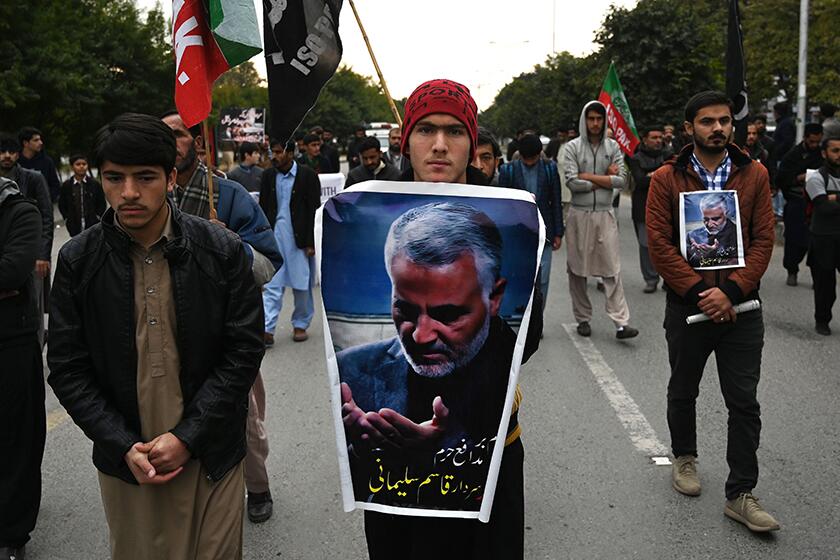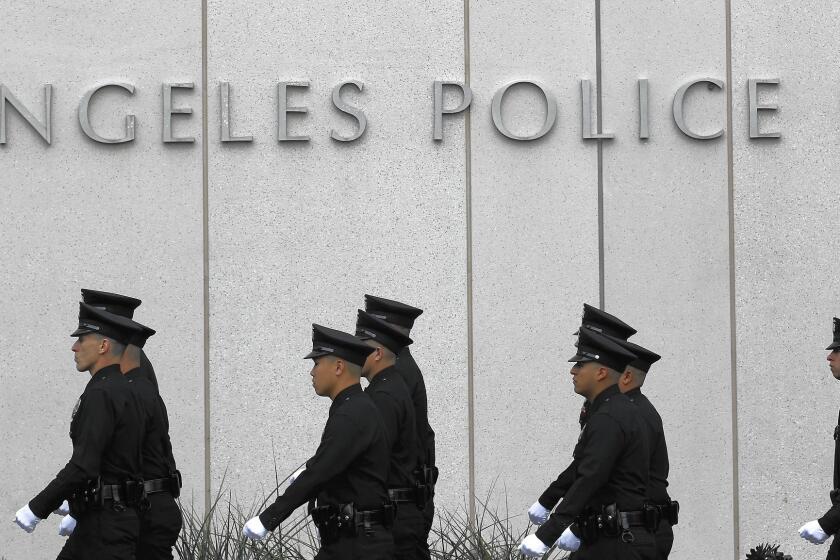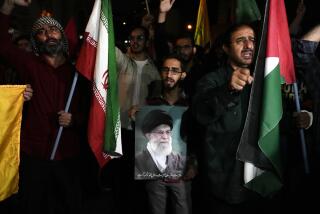Who was Qassem Suleimani, and what does his death mean for the U.S.?

The U.S. airstrike ordered by President Trump that killed Gen. Qassem Suleimani, the powerful and shadowy head of Iran’s elite Quds Force, marks a major escalation in U.S.-Iran tensions and raises concerns about renewed conflict in the Middle East.
Here are some significant facts about Suleimani, his role in the region and what his death means for the U.S.
Who was Suleimani, and why was he important?
Suleimani was the longtime commander of Iran’s Quds Force, an external wing of the Islamic Revolutionary Guard Corps. Suleimani played an important role in Iran’s national security decision making process — including weapons sales, training and financing armed groups in other Middle Eastern nations — and reported directly to Supreme Leader Ayatollah Ali Khamenei.
Suleimani’s strong influence and relationships with various militias and terrorist groups — which allowed Shiite-dominated Iran to build a network of non-state Shiite allies — helped expand Iran’s role in the region. His death, analysts said, is likely to result at some point in bloody retaliation.
The targeted killing of Iranian Gen. Qassem Suleimani unleashed debate on Capitol Hill over whether the action amounted to an act of war and if the White House had the authority to undertake it without congressional approval.
Commander of the Quds Force for more than two decades, Suleimani earned his stripes while serving as a Revolutionary Gard divisional commander during the Iran-Iraq war of the 1980s.
In 2007, the U.S. Department of Treasury sanctioned the Quds Force for supporting the proliferation of weapons of mass destruction. But there were also moments when the U.S. found itself on the same side. Shortly after the Sept. 11, 2001, attacks, for instance, Iran reportedly gave the U.S. information to help forces overthrow the Taliban.
Suleimani also played a prominent role in the fight against Islamic State militants. In 2016, he was placed in charge of leading the Quds Force against Islamic State militants in Iraq.
Despite operating out of the spotlight, Suleimani’s popularity in Iran grew over the last decade, and he emerged as one of the country’s most popular figures. A recent poll conducted in Iran by the University of Maryland revealed that Suleimani was ranked more favorably than President Hassan Rouhani and Foreign Minister Javad Zarif.
How was he a regional power player?
Suleimani was well known for his ability to cultivate personal relationships with various militia groups in the Middle East, including Shiite militias in Iraq, Hezbollah in Syria and Lebanon and the Houthis in Yemen.
In doing so, Suleimani has been credited by Iranian officials with being instrumental in building armed networks across the Middle East to help extend Iran’s regional influence. Starting in 2005, for instance, Suleimani coordinated Iraqi Shiite militias to fight against U.S. forces.
Southern California is home to one of the largest Iranian diasporas in the world, and we want to hear from members of the community.
Why did Trump want him killed?
Trump told reporters Friday that he ordered the killing to prevent future attacks on Americans. The Department of Defense said in a recent statement that the reclusive commander was “actively developing plans to attack American diplomats and service members in Iraq and throughout the region.”
The Pentagon stated that Suleimani was behind an attack on a Kirkuk military installation in late December that resulted in the death of an American contractor and the wounding of four American troops.
Still, the question remains about who benefits from an attack that killed such a high-level figure.
The answer lies in Suleimani’s role in cultivating proxies over the years, which have at times provoked and worked against American interests in the Middle East. For instance, the U.S. Central Command declassified documents in 2015 that showed that under Suleimani’s leadership, Iraqi Shiite militants killed over 500 U.S. service members in Iraq between 2005 and 2011. Most recently, pro-Iranian militia members were behind the storming of the U.S. Embassy compound in Baghdad.
Consequently, killing Suleimani sends Iran a warning to stop theprovocations. Even though Suleimani was not the sole decision maker when it came to Iran’s foreign policy objectives, said Ariane Tabatabai, a Middle East expert at Rand Corp., the death of a military figure who was instrumental in helping cultivate Iranian proxies sends a symbolic message to Iran.
Why is Suleimani’s death a big deal?
Suleimani’s death could quell the Islamic Republic’s ability to continue cultivating its network of militia groups and terrorist groups in countries such as Iraq, Syria, Yemen and Lebanon, analysts say. At the same time, it could eventually — if not immediately — result in retaliation.
Although Trump said Friday he disagrees that his decision to kill Suleimani would increase conflict in the already volatile region, analysts aren’t so sure. Tabatabai said Suleimani’s death introduces a new level of risk.
“This is unknown terrain that we are now going to discover as we deal with the situation,” she said.
Global powers warned Friday that the world has become a more dangerous place and urged restraint after the U.S. assassinated Iran’s top general.
Was Trump’s ordering of the U.S. airstrike that killed Suleimani legal?
Under the United Nations charter, there are three legal avenues that a country can use to justify military force against a foreign country.
- A country can respond in self-defense if it has been on the receiving end of an armed attack
- A country can assist an ally if it is attacked and requests help
- If a country is involved in a civil war, it has the right to invite other countries to help
Based on statements the U.S. government has so far released claiming Suleimani intended to attack American diplomats and service members in Iraq, various international law experts have different interpretations of whether the attack was legally justified.
Hina Shamsi, national security project director for the American Civil Liberties Union, said that under the White House’s initial justification — that Suleimani was in the process of planning an attack on Americans working in Iraq — the airstrike would not have met the threshold under international law of “an act of self-defense against an imminent attack.”
She added: “After almost two decades of expansive presidential claims of authority to use force abroad, Congress needs to robustly exercise the oversight and restraining powers that are integral to our system of checks and balances.”
Killing of Iranian general has authorities in California boosting security and eyeing Iranian assets
Jonathan Miller, a professor of international law and constitutional law at Los Angeles-based Southwestern Law School, has a different perspective.
“The U.S. can justify force against Suleimani if it feels that Iran was behind attacks on U.S. forces. The situation becomes more complex given that Iran often operates through proxies, but Iran is responsible for the conduct of its proxies if those proxies carry out attacks under its instruction,” he said.
“Of course any use of force in response to an armed attack must be proportional, but in this case we are talking about a very limited strike that focused on an individual whose command responsibilities directly involved him with the Shiite militia who were attacking U.S. forces.”
Are we on the path toward World War III? And how unlikely is the reinstitution of a draft?
The short answer: no and no.
Recent events might have some young people worried that the U.S. is marching toward war with Iran — “World War III” started trending on social media after Suleimani’s death was announced.
But the reality is that a direct conflict remains unlikely; even though the risk of miscalculation by the U.S. and Iran might be higher these days than in the past, neither side wants to end up in a direct conflict, Tabatabai said.
The same goes for reinstitution of a draft.
The U.S. has fought in at least three major wars since the Vietnam War, when the U.S. military draft drew to a close. In order for a draft to be reinstated, Congress would have to pass a law that would then be signedby the president.
More to Read
Sign up for Essential California
The most important California stories and recommendations in your inbox every morning.
You may occasionally receive promotional content from the Los Angeles Times.














